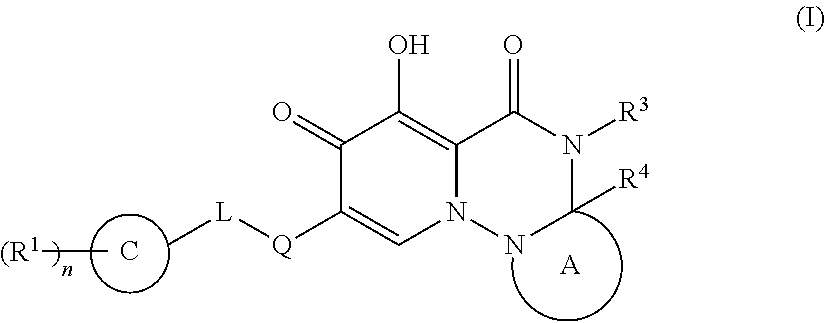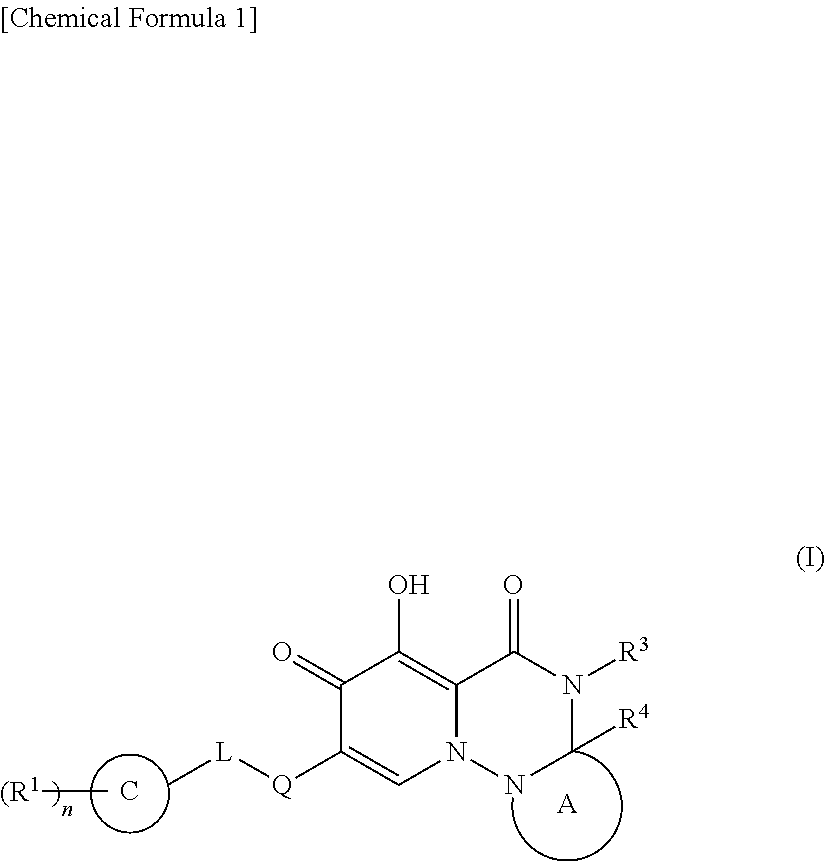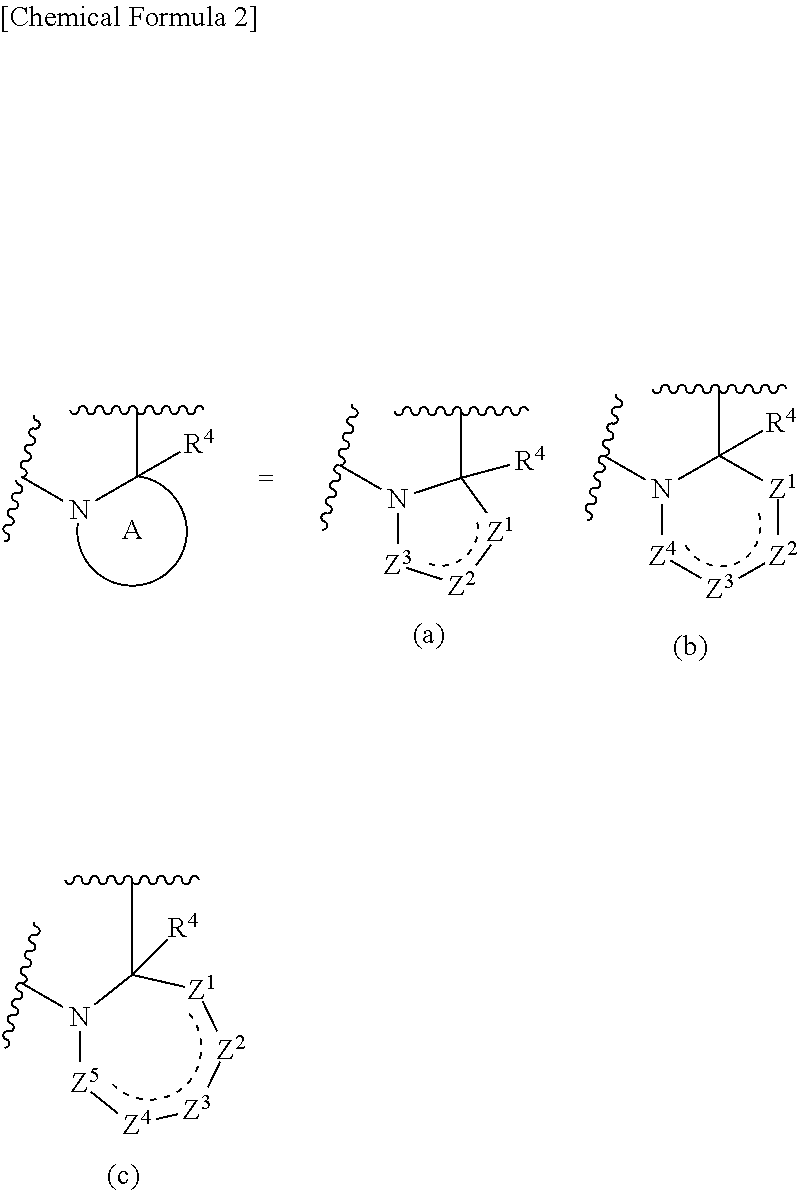Polycyclic pyridone derivative
- Summary
- Abstract
- Description
- Claims
- Application Information
AI Technical Summary
Benefits of technology
Problems solved by technology
Method used
Image
Examples
example 1
[0280]
Step 1
[0281]To compound 1 (1.50 g, 3.59 mmol), a 2 mol / L solution of ethylamine in methanol (17.9 ml, 35.9 mmol) was added, and the mixture was stirred at 100° C. for 1 hour under microwave irradiation. The solvent in the reaction solution was distilled off under reduced pressure. Then, the residue was rendered acidic by the addition of dilute hydrochloric acid, followed by extraction with ethyl acetate. The organic layer was dried over sodium sulfate, and the solvent was then distilled off. The obtained residue was purified by silica gel column chromatography (chloroform-methanol) to give compound 2 (1.15 g, yield: 74%).
[0282]1H-NMR (CDCl3) δ: 14.53 (s, 1H), 8.64 (brs, 1H), 8.46 (s, 1H), 7.37 (m, 5H), 6.57 (brs, 1H), 5.38 (s, 2H), 3.24 (dt, J=14.0, 6.6 Hz, 2H), 1.45 (s, 9H), 1.02 (t, J=7.3 Hz, 4H).
Step 2
[0283]To a solution of compound 2 (3 g, 6.95 mmol) in DMF (60 ml), potassium carbonate (2.02 g, 14.6 mmol) and 2-(4-bromobutyl)-1,3-dioxolane (2.53 ml, 16.7 mmol) were added, ...
example 2
[0302]
Step 1
[0303]A solution of compound 12 (12 g, 48.7 mmol) in DMF (60 mL) was cooled to 0° C. HOBt (7.9 g, 58.5 mmol), EDC (11.2 g, 58.5 mmol), triethylamine (8.1 mL, 58.5 mmol) and ethylamine hydrochloride (4.8 g, 58.5 mmol) were added thereto, and the mixture was stirred at room temperature for 1 hour. Water was added to the reaction solution, followed by extraction with ethyl acetate. The organic layer was washed with brine and dried over anhydrous sodium sulfate, and the solvent was then distilled off under reduced pressure. The obtained solid was suspended in isopropyl ether and collected by filtration to give compound 13 (10.7 g, yield: 80%).
[0304]1H-NMR (CDCl3) δ: 7.84 (d, J=5.8 Hz, 1H), 7.69 (s, 1H), 7.41-7.39 (m, 5H), 6.49 (d, J=5.5 Hz, 1H), 5.41 (s, 2H), 3.29-3.26 (m, 2H), 0.97 (t, J=7.3 Hz, 3H).
Step 2
[0305]Compound 13 (10 g, 36.6 mmol) was dissolved in DMA (100 mL). To the solution, pyridinium p-toluenesulfonate (27.6 g, 109.8 mmol) was added, and the mixture was then ...
example 3
[0320]
Step 1
[0321]To a solution of compound 24 (528 mg, 2.10 mmol) in THE (5.0 mL), sodium hydride (60 wt %, 135 mg, 3.38 mmol) was added at 0° C., and the mixture was stirred at 0° C. for 10 minutes. Compound 25 (500 mg, 2.415 mmol) was added to the reaction solution, and the mixture was raised to room temperature and reacted overnight. Water was added to the reaction solution, followed by extraction with ethyl acetate. The organic layer was washed with brine and dried over anhydrous sodium sulfate, and the solvent was then distilled off. The obtained residue was purified by silica gel column chromatography (hexane-ethyl acetate) to give compound 26 (517 mg, yield: 67%).
[0322]MS: m / z=321 [M+H]+
Step 2
[0323]Compound 26 (89 mg, 0.278 mmol), compound 21 (60 mg, 0.139 mmol), cesium carbonate (68 mg, 0.208 mmol), and tetrakistriphenylphosphinepalladium (16 mg, 0.014 mmol) were dissolved in dioxane (1.8 mL), and the mixture was reacted at 90° C. for 7 hours. Water was added to the reactio...
PUM
| Property | Measurement | Unit |
|---|---|---|
| Molar density | aaaaa | aaaaa |
| Molar density | aaaaa | aaaaa |
| Molar density | aaaaa | aaaaa |
Abstract
Description
Claims
Application Information
 Login to View More
Login to View More - R&D
- Intellectual Property
- Life Sciences
- Materials
- Tech Scout
- Unparalleled Data Quality
- Higher Quality Content
- 60% Fewer Hallucinations
Browse by: Latest US Patents, China's latest patents, Technical Efficacy Thesaurus, Application Domain, Technology Topic, Popular Technical Reports.
© 2025 PatSnap. All rights reserved.Legal|Privacy policy|Modern Slavery Act Transparency Statement|Sitemap|About US| Contact US: help@patsnap.com



